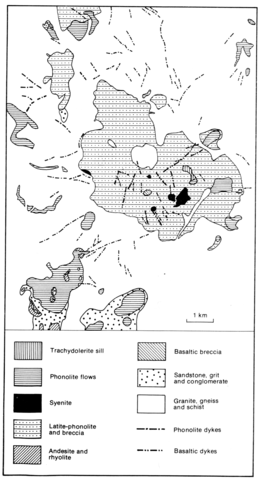stripes
The Cripple Creek district lies in a dome-like flexure at the southwestern end of the Front Range and consists mainly of Precambrian granite, gneiss and schist, but in an area immediately east of the town of Cripple Creek and capping surrounding hills are sediments and volcanics of Tertiary age. The structure of the central area is far from clear, but it appears to be a caldera filled with sediments overlain by tuffs, probably derived from local fissure eruptions. The tuffs are mainly phonolites and latite-phonolites which are intruded by sills, or possible flows (Koschmann, 1949, p. 26), of trachyphonolite, trachydolerite and trachyte and stocks and dykes of feldspathoidal syenite. Phonolite forms flows capping many of the surrounding hills and dykes and sills which have been exposed in several mines. The phonolites comprise alkali feldspar, nepheline, sodalite, nosean, analcime, aegirine, occasional blue sodic amphibole, biotite and accessories, and these pass into trachyphonolites, mainly with reduction in nepheline. The syenites contain microperthite, sodic plagioclase, analcime, sodalite, subordinate nepheline, aegirine-augite, amphibole and biotite. Possible leucite has been detected in a specimen of tuff (Lindgren and Ransome, 1906, p. 67). Dyke rocks include phonolites, trachydolerites, vogesite and monchiquite and one example of a 'melilite basalt' has been recognized (Loughlin and Koschmann, 1935, p. 252). A very detailed petrographic and mineralogical account of the Cripple Creek area with some chemical data will be found in Lindgren and Ransome (1906), and a detailed stratigraphy accompanies the reconnaissance geological map of Wobus et al. (1976).
BARKER, D.S. 1974. Alkaline rocks of North America. In H. Sorensen (ed.). The Alkaline Rocks. John Wiley, London: 160-71.
KOSCHMANN, A.H. 1949. Structural control of the gold deposits of the Cripple Creek district, Teller County, Colorado. Bulletin, United States Geological Survey, 955-B: 1-19-60.
LINDGREN, W. and RANSOME, F.L. 1906. Geology and gold deposits of the Cripple Creek district, Colorado. Professional Paper, United States Geological Survey, 54: 1-516.
LOUGHLIN, G.F. and KOSCHMANN, A.H. 1935. Geology and ore deposits of the Cripple Creek district, Colorado. Proceedings, Colorado Scientific Society, 13: 215-435.
MCDOWELL, F.W. 1971. K-Ar ages of igneous rocks from the western United States. Isochron/West, New Mexico Bureau of Mines and Mineral Resources, 2: 1-16.
THOMPSON, T.B., TRIPPEL, A.D. and DWELLEY, P.C. 1985. Mineralized veins and breccias of the Cripple Creek district, Colorado. Economic Geology, 80: 1669-88.
WOBUS, R.A., EPIS, R.C. and SCOTT, G.R. 1976. Reconnaissance geologic map of the Cripple Creek - Pikes Peak area, Teller, Fremont, and El Paso Counties, Colorado. United States Geological Survey, Miscellaneous Field Studies Map: MF-805

